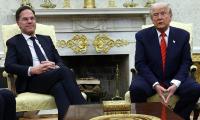The US and China are struggling to strike an interim deal in a protracted trade conflict that has begun to weigh down on global markets, hammered world economic growth and the manufacturing activity.
The so called Phase 1 deal envisaged an agreement on agriculture, financial services and currency in a bid to end the tit-for-tat trade war broiling for more than a year. The second phase of negotiations will address complex issues like forced technology transfer and non financial services. Threats of tariffs, however, loom large in the fog of uncertainty if the peace deal fails to take off.
Since March 218, when Trump first imposed tariffs on Chinese goods worth billions of dollars, there have been series of escalation and de-escalation of tensions amidst bellicose rhetoric. China has retaliated likewise by slapping tariffs on US goods and being tough in ceding concessions. As the trade deficit increases, Trump believes, erroneously, that it can be reduced by waging a tariff war with trade-surplus China. However, economists have pointed out that trade deficit is a poor assessment of the health of an economy.
The trade deficit continues to widen due to greater purchases of foreign products by America in demand of a growing economy. Besides, the trade war has not had the desired effect of reducing trade deficit with China, which rose to $500 billion in the first three quarters of 2019 from $481.3 billion last year, despite increasing tariffs, raising concern for Trump. This can be reduced if China agrees to buy more US goods by negotiating a deal and not heightening further tariffs.
The US thinks that China’s trade surplus is largely because of unfair trade practices; subsidizing its
industries, imposing non-tariff barriers on US exports, stealing American intellectual property, depressing the value of its currency to gain unfair advantage and using technology discreetly for spying and surveillance. As an arm twisting measure, the US blacklisted and subsequently banned many Chinese companies, notably among them Huawei, and their products in America thus broadening the scope of trade war from the realm of reckless tariffs to a ravaging tech war, hampering commercial business activity and disturbing global value supply chains.
The direct impact of the trade war has been grave — an overall contraction in manufacturing activity in the US, UK, EU, China, and Asia. There have been billions of dollars of losses for both the US and China, hitting industries like agriculture, autos, technology in the tug of trade war.
China’s economy slowed down to 6 percent in the third quarter of 2019, down from 6.8 percent last year, raising economic challenges for the Chinese president alongside the ensuing political turmoil in Hong Kong. A slow Chinese economy is a risk to many East Asian economies dependent on exports, tourism and direct investment in China. The ongoing US-China trade tensions amidst slowing global demand have kept the manufacturing activity weak and exports low across Asia particularly in Malaysia, Indonesia, Vietnam, Japan, South Korea and Taiwan.
The IMF has predicted that “prolonged trade policy uncertainty is damaging the world economy’’ and cut forecast for global growth and expects world economy to expand by just 3 percent compared with 3.6 percent last year, the slowest rate since the global financial crisis. According to the IMF, the direct impact of the US-China tariff war could reduce America’s GDP by 0.2 percent by next year whereas the harmful indirect impact may bring damage to about 0.6 percent of GDP in 2020. The damage to China could be almost 2 percent of GDP, as predicted by the IMF. The damage is greater to China in GDP terms as it exports more to the US than the other way around.
American and Chinese consumers and producers are “unequivocally the losers” of the trade war. But the good news is that trade will continue to expand, despite US-China tensions. The producers and companies that have been affected due to the tariff war in order to protect themselves against future interruptions of new tariffs have outsourced their materials or factories to more than one country.
Vietnam, Mexico and Brazil, Taiwan and Malaysia have greatly benefitted from the outcome of the US-China trade friction as an alternate destination for outsourcing, investment and trade for many countries including the US and China. The push towards diversified supply chains will make global trade more resilient in the long term.
“Trade wars are good and easy to win”, Trump tweeted at the outset of the trade war in March 2018. After eighteen months of protracted friction, it has been seen that trade wars are hideous and hopeless — weighing upon the global economy, hampering manufacturing output. Cnsumers and producers pay the most price and winners, paradoxically, remain elsewhere.
The writer holds an LLM degree in international economic law from the University of Warwick.
Email: beelam_ramzan@yahoo.com
People of that time believed that an eclipse was a symbol of displeasure of gods
Vertically speaking, dominance of domestic debt in Pakistan’s debt portfolio is haunting
Loss of biodiversity is stark reminder that urban mismanagement is not just infrastructural failure but ecological...
Strong public warning systems can also help ensure quick evacuations in places prone to fires
PPPs in Pakistan's WASH sector face significant regulatory and policy challenges that hinder their effectiveness
Instead, it would have powerful chairman with three-year term, appointed at prime minister’s discretion







